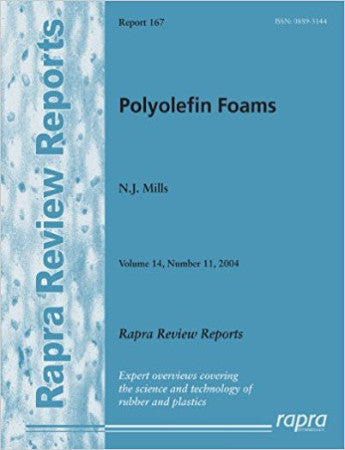Polyolefin Foams
Polymer Foams are used in many different types of applications and it is hard to find an area where they are not utilised. Polyolefin Foams are a relatively recent development compared to the other types of foam. The Polyolefin foam processes were developed in the 1960s and 1970s.
This Review starts with a brief history of the subject and then reports on the current situation regarding Polyolefin Foams. The section on processing discusses the properties required for successful foam production. The polymer section then describes the molecular structures necessary to produce the required properties and then considers novel polymer that can be used for foams. The properties section covers the mechanical and thermal properties and how these can be used to best advantage, while the applications section discusses how these properties can be used.
This Review starts with a brief history of the subject and then reports on the current situation regarding Polyolefin Foams. The section on processing discusses the properties required for successful foam production. The polymer section then describes the molecular structures necessary to produce the required properties and then considers novel polymer that can be used for foams. The properties section covers the mechanical and thermal properties and how these can be used to best advantage, while the applications section discusses how these properties can be used.
1 Introduction
2 Polymers
2.1 Polyethylenes
2.1.1 Blends
2.2 Ethylene-Styrene ‘Interpolymers’
2.3 EPDM
2.4 Polypropylenes
3 Processing
3.1 Melt Rheology Suitable for Foaming
3.2 Foam Expansion
3.2.1 Control of Cell Size and Cell Stability
3.2.2 Control of Density
3.3 Post-Extrusion Shrinkage
3.4 Rotomoulding
3.5 Microcellular Foams
3.6 Oriented PP Foams – Strandfoam <
4 Mechanical Properties
4.1 Initial Response in Compression
4.2 Bulk Modulus
4.3 Compressive Collapse
4.4 High Strain Compressive Response
4.5 Heat Transfer from Gas to Polymer During High Strain Compression
4.6 Creep Response and Air Loss from Cells
4.7 Recovery After Creep
4.8 Fatigue
4.9 Cushion Curves for Impact Response
4.10 Impact Response in Shear or Shear Plus Compression
4.11 Recovery After Impact
4.12 Multiple Impacts
5 Thermal Properties
5.1 Dynamic Mechanical Thermal Analysis (DMTA)
5.2 Thermal Expansion
5.3 Thermal Conductivity
6 Applications
6.1 Packaging Against Impact Damage
6.2 EVA in Running Shoe Midsoles
6.3 Body Armour
6.4 Helmets
6.5 Soccer Shin Protectors
6.6 Automotive
7 Market Growth
2 Polymers
2.1 Polyethylenes
2.1.1 Blends
2.2 Ethylene-Styrene ‘Interpolymers’
2.3 EPDM
2.4 Polypropylenes
3 Processing
3.1 Melt Rheology Suitable for Foaming
3.2 Foam Expansion
3.2.1 Control of Cell Size and Cell Stability
3.2.2 Control of Density
3.3 Post-Extrusion Shrinkage
3.4 Rotomoulding
3.5 Microcellular Foams
3.6 Oriented PP Foams – Strandfoam <
4 Mechanical Properties
4.1 Initial Response in Compression
4.2 Bulk Modulus
4.3 Compressive Collapse
4.4 High Strain Compressive Response
4.5 Heat Transfer from Gas to Polymer During High Strain Compression
4.6 Creep Response and Air Loss from Cells
4.7 Recovery After Creep
4.8 Fatigue
4.9 Cushion Curves for Impact Response
4.10 Impact Response in Shear or Shear Plus Compression
4.11 Recovery After Impact
4.12 Multiple Impacts
5 Thermal Properties
5.1 Dynamic Mechanical Thermal Analysis (DMTA)
5.2 Thermal Expansion
5.3 Thermal Conductivity
6 Applications
6.1 Packaging Against Impact Damage
6.2 EVA in Running Shoe Midsoles
6.3 Body Armour
6.4 Helmets
6.5 Soccer Shin Protectors
6.6 Automotive
7 Market Growth
Nigel Mills, D.Eng., Ph. D, F.I.M. graduated in Natural Sciences from Kings College, Cambridge, and then worked for ICI Petrochemical and Polymer Laboratory in Runcorn from 1964 to 1970. Since then he has been at Birmingham University, where he is currently Reader in Polymer Engineering, in the Metallurgy and Materials Department. His research interests include modeling and testing the mechanical properties of polymer foams, and the testing and design of protective helmets, clothing, and shoes. The latter involves linking injury criteria to product performance tests. His research group is equipped for impact, creep and fracture testing of foams and plastics, and testing of helmets and sports equipment. He is chairman of the British Standards committee for motorcycle helmets. He has published 140 papers on foam and polymer properties and applications.




